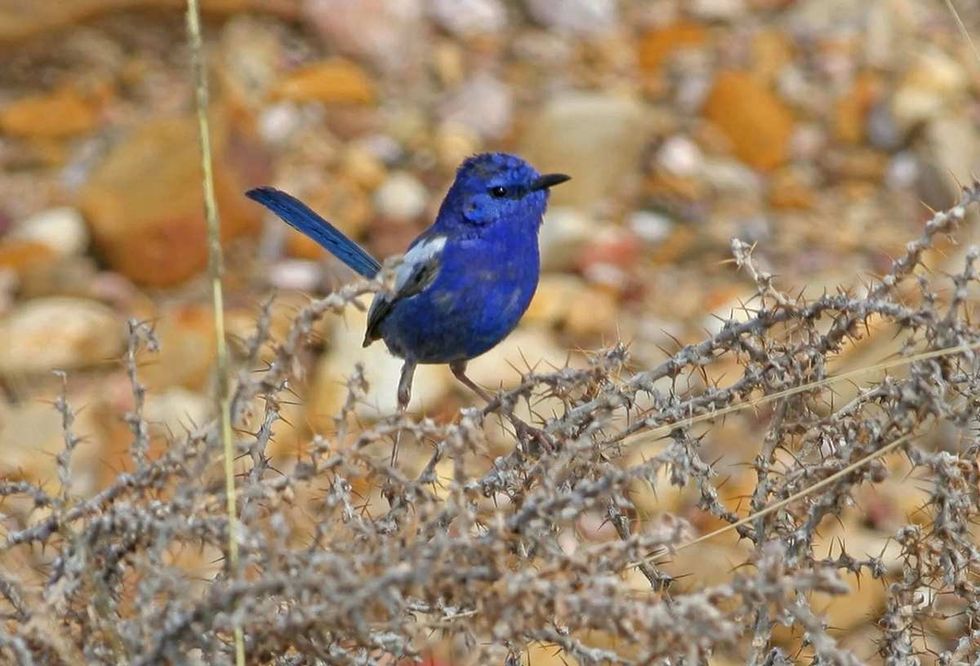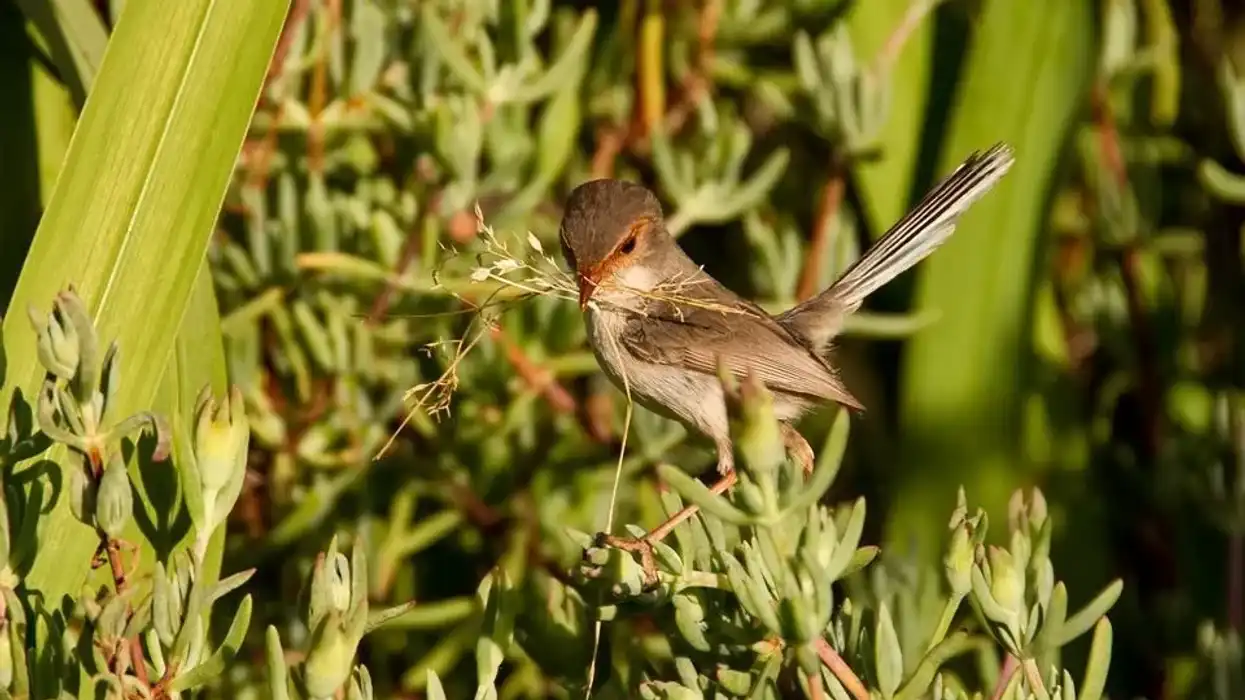A small bird with a blue and white plumage and long tail, the white-winged fairy-wren (Malurus leucopterus) is a species of songbird endemic to mainland Australia.
Belonging to the Australasian wren family Maluridae, the white-winged fairy-wren has three recognized subspecies - the mainland subspecies, the one on Dirk Hartog Island, and the third on the Barrow Island situated off the coast of Western Australia.
The fairy-wrens of Australia are famed for being a visual treat. The white-winged fairy-wren (Malurus leucopterus) is no exception.
In fact, it is one of the most brilliantly colored fairy-wrens with visually striking breeding plumage. However, the bright, sapphire blue and white breeding plumage of the white-winged fairy-wren is only specific to the male birds.
In non-breeding males and females, the plumage is bland and gray. In breeding males, the long, white and blue tail is almost always held upright and is rarely still.
The tiny white-winged fairy-wrens are well adapted to dry environments and mostly inhabit open, semi-arid, and arid locales with sparse bushes. Even though the white-winged fairy-wren is primarily insectivorous and feeds on insects, it also feeds on seeds, fruits, and other plant material.
There is more to the spectacular blue white-winged fairy-wren. Read on to discover!
If you enjoy learning about the white-winged fairy-wren, you may also like to read about the hawk and house wren.
White-winged Fairy Wren Interesting Facts
What type of animal is a white-winged wairy fren?
The white-winged fairy-wren (Malurus leucopterus) is a species of songbird belonging to the wren family Maluridae. The tiny white-winged fairy-wrens are known for their unmistakable white and blue breeding plumage of the males.
What class of animal does a white-winged fairy wren belong to?
The white-winged fairy-wren (Malurus leucopterus) belongs to the class of birds (class Aves).
How many white-winged fairy wrens are there in the world?
The total population estimate of the white-winged fairy-wren (Malurus leucopterus) is unavailable. However, the International Union for Conservation of Nature (IUCN) Red List of Threatened Species lists the white-winged fairy-wren as having a stable global population.
Where does a white-winged fairy wren live?
The white-winged fairy-wren (Malurus leucopterus) is well-suited to dry habitats. The species is mostly found in low shrublands of semi-arid and arid areas. They are particularly common in shrublands dominated by saltbush.
What is a white-winged fairy wren's habitat?
The distribution range of the white-winged fairy-wren includes the coast of Western Australia, the Barrow Island, and the Dirk Hartog Island and east into the mainland covering southern and central Queensland, northwestern Victoria, and New South Wales.
White-winged fairy-wrens are normally resident in one area but may undergo local movements outside the breeding season. Red-backed fairy-wrens replace the white-winged fairy-wrens north of the 20 degrees South latitude.
Where vegetation is taller, the white-winged fairy-wrens get replaced by the splendid fairy-wren. The white-winged fairy-wren nest is a domed structure made up of fine grasses, lined with feathers and plant down, and having a side entrance. The nests are usually placed on thick shrubs, usually close to the ground.
Who do white-winged fairy wrens live with?
White-winged fairy-wrens live in social groups, each clan consisting of about two to four birds. There is usually a breeding female white-winged fairy-wren and a partially blue or brown male.
Besides, the white-winged fairy-wrens are cooperative or communal breeders whereby helper birds assist in raising the young. Fairy-wrens in a group usually roost next to one another, often engaging in mutual preening. A clan usually consists of several subgroups living in a territory, dominated by a blue male that dons the breeding plumage.
How long does a white-winged fairy wren live?
The lifespan estimate of the white-winged fairy-wren is not available. However, the superb fairy-wren, a different fairy-wren species of has an average lifespan of two years.
How do they reproduce?
In white-winged fairy-wrens, the breeding season has been reported all year round, particularly in the population inhabiting the arid regions of northern and central Australia. Those to the southwest of Western Australia usually breed during the spring.
The white-winged fairy-wrens live in groups and have complex social bonds.
Every female white-winged fairy-wren in a group has a male partner in dull brown plumage and a single male partner sporting the bright blue breeding plumage. The dominant blue breeding male in the group has its own female partner, whereas females have several male non-breeding helpers in brown plumage.
Egg-laying usually takes place from September to January when a female white-winged fairy-wren lays a clutch comprising three to four eggs. Incubation lasts 13-14 days, solely done by the female.
However, the blue breeding male or a brown male along with the nest helpers assist in feeding the nestlings. The nestlings do not leave the nest until about 10-11 days.
Even after they have left the nest, the adult members continue to feed them for three to four weeks. The young fairy-wrens may remain in the family group to help raise subsequent broods.
What is their conservation status?
As per the International Union for Conservation of Nature (IUCN) Red List of Threatened Species, the white-winged fairy-wren is a species of Least Concern with a globally stable population.
White-winged Fairy Wren Fun Facts
What do white-winged fairy wrens look like?
The male and female white-winged fairy-wrens have pretty distinct plumage colors. The adult breeding male has a beautiful sapphire blue plumage with white wings, white shoulder patches, and a medium to dark blue tail.
While the striking blue plumage color is typical of the mainland subspecies, those on the Barrow and Dirk Hartog Islands off the coast of Western Australia have a glossy black plumage with white wings and shoulder patch.
In comparison to the male, the female white-winged fairy-wren is duller with grayish-brown wings, back, and crown, and a gray tail with a faint wash of blue. The underparts are whitish with dull buff flanks. The immature birds closely resemble females, and males do not assume the blue plumage until about their fourth year.
How cute are they?
The sheer tiny size of the white-winged fairy-wren makes it an extremely cute and adorable bird. The bright blue color of the breeding male's plumage adds more beauty.
How do they communicate?
Being a species of songbird, the white-winged fairy-wren is quite vocal with variety in calls. The song of the bird consists of a few short opening notes followed by an extended reel lasting for up to four seconds with rising and falling pitch.
The contact call is a harsh 'trit', and the alarm calls are loud and abrupt with varying intensity and frequency.
How big is a white-winged fairy wren?
A white-winged fairy-wren measures between 4.3-5.3 in (11-13.4 cm). It is almost of the same size as the splendid fairy-wren (Malurus splendens).
How fast can a white-winged fairy wren fly?
The flight speed of the white-winged fairy-wrens is not available. Their usual form of movement is hopping and may also perform the rodent-run display to distract predators from nests and chicks.
During the rodent-run display, the fairy-wrens fluff up their feathers, lower the tail, head, and neck, and run rapidly with wings held out, continuously giving out an alarm call.
How much does a white-winged fairy wren weigh?
On average, a white-winged fairy-wren weighs between 0.2-0.3 oz (5.6-8.5 g).
What are the male and female names of the species?
Male and female fairy-wrens do not have distinct names.
What would you call a baby white-winged fairy wren?
A baby white-winged fairy-wren would be called a chick, nestling, or fledgling.
What do they eat?
The white-winged fairy-wrens are primarily insectivorous with a diet mainly consisting of caterpillars, praying mantises, moths, bugs, beetles, and spiders. The birds may supplement their diet with seeds, fruits, and shoots of saltbush plants.
Are they dangerous?
The white-winged fairy-wren is not known to be dangerous. However, the birds can be quite defensive about their territories.
Would they make a good pet?
No, it is not a good idea to keep the white-winged fairy-wren as a pet. Despite their adorable appearance, the birds are wild and are not suited to a household setting. Besides, they require large open spaces and have an insectivorous diet which may be difficult to provide for.
Did you know...
Common predators of the white-winged fairy-wren include feral cats, red foxes, butcherbirds, Australian magpie, laughing kookaburra, ravens, crows, currawongs, shrike-thrushes, and goannas.
The white-winged fairy-wren is prone to nest parasitism by the Horsefield's bronze cuckoo.
The blue plumage of the white-winged fairy-wren strongly reflects ultraviolet light that makes them noticeable to other members.
A mature male white-winged fairy-wren molts twice a year, once after the breeding season in autumn and once before that in winter or spring.
Different types of fairy wren
There are about 10 species of the fairy-wren in Australia, all belonging to the family Maluridae and genus Malurus. The different species are the superb fairy-wren, the splendid fairy-wren, the purple-crowned fairy-wren, the red-backed fairy-wren, the lovely fairy-wren, the variegated fairy-wren, the purple-backed fairy-wren, the blue-breasted fairy-wren, the red-winged fairy-wren, and the white-winged fairy-wren.
Naming white-winged fairy wren
The common English name of the white-winged fairy-wren comes from the breeding male's white wings. Other names of the bird include the white-winged wren, the white-backed wren, and the white-backed fairy-wren.
Here at Kidadl, we have carefully created lots of interesting family-friendly animal facts for everyone to discover! For more relatable content, check out these bowerbird facts and umbrellabird facts for kids.
You can even occupy yourself at home by coloring in one of our free printable scarlet robin coloring pages.
Second image by Xavier Schmit.










